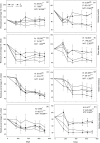Changes in litter quality induced by nutrient addition alter litter decomposition in an alpine meadow on the Qinghai-Tibet Plateau
- PMID: 27694948
- PMCID: PMC5046129
- DOI: 10.1038/srep34290
Changes in litter quality induced by nutrient addition alter litter decomposition in an alpine meadow on the Qinghai-Tibet Plateau
Abstract
The effects of nitrogen (N) and phosphorus (P) addition on litter decomposition are poorly understood in Tibetan alpine meadows. Leaf litter was collected from plots within a factorial N × P addition experiment and allowed to decompose over 708 days in an unfertilized plot to determine the effects of N and/or P addition on litter decomposition. Results showed that nutrient addition significantly affected initial P and P-related biochemical properties of litter from all four species. However, the responses of litter N and N-related biochemical properties to nutrient addition were quite species-specific. Litter C decomposition and N release were species-specific. However, N and P addition significantly affected litter P release. Ratios of Hemicellulose + Cellulose to N and P were significantly related to litter C decomposition; C:N ratio was a determinant of litter N release; and C:P and (Hemicellulose + Cellulose):P controlled litter P release. Overall, litter C decomposition was controlled by litter quality of different plant species, and strongly affected by P addition. Increasing N availability is likely to affect litter C decomposition more indirectly by shifting plant species composition than directly by improving litter quality, and may accelerate N and P cycles, but shift the ecosystem to P limitation.
Figures


References
-
- Aerts R. & Chapin F. S. III The mineral nutrition of wild plants revisited: A re-evaluation of processes and patterns. Adv Ecol Res 30, 1–67 (1999).
-
- Berg B. & McClaugherty C. Plant litter – decomposition, humus formation, carbon sequestration (third edition) (Springer 2014).
-
- Zhang D., Hui D., Luo Y. & Zhou G. Rates of litter decomposition in terrestrial ecosystems: global patterns and controlling factors. Journal of Plant Ecology 1, 85–93 (2008).
-
- Prescott C. E. Litter decomposition: what controls it and how can we alter it to sequester more carbon in forest soils? Biogeochemistry 101, 133–149 (2010).
-
- Aerts R. Climate, Leaf Litter Chemistry and Leaf Litter Decomposition in Terrestrial Ecosystems: A Triangular Relationship. Oikos 79, 439–449 (1997).
Publication types
MeSH terms
Substances
LinkOut - more resources
Full Text Sources
Other Literature Sources

